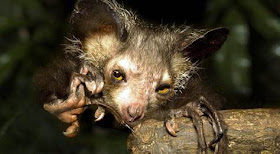Prepare to be assaulted by cute pictures and amazing discoveries! By the end of this post you will never look at the mammal world in the same way.
As I walked into the lemur enclosure during my discovery-filled visit to the Duke Lemur Center as part of the Science Online 2012 conference, I was impressed not only with the lemurs' musky odor but also with their piercing eyes. So intense, so seemingly interested!
 |
| Coquerel's Sifaka (mother and child) living large at the Duke Lemur Center. via their Blog. |
I was privileged with such an up-close view because the lemurs were in their indoor/outdoor enclosures to escape the chilly North Carolina winters. Lemurs are accustomed to the warmer tropical climate of their home island Madagascar.

The Duke Lemur Center houses the largest colony of lemurs outside of this island nation, and as part of their research and conservation efforts they make sure their lemurs have ample opportunity to "make the sex" (procreate). In fact, I visited in January at the very heart of Coquerel's Sifaka birth season. This unstoppably cute Coquerel's Sifaka baby was born just days before I visited.
 |
| I dare you to find a cuter pro-simian primate picture!! via Duke Lemur Center Blog. |
Understandably, they wouldn't let me anywhere near the babies, but they did show me these two photos. The puffball of adorableness on the left is a pygmy slow loris (not a lemur, but related) and the craziness on the right is my favorite lemur, an aye-aye. Can you believe the contrast?!
 |
| Baby Battle: Pygmy Slow Loris vs. Aye-aye |
Cute/crazy-looking babies are only the beginning of the wonders of the lemur world. By studying lemurs' DNA and that of other primates, scientists can tell that lemurs and other African primates parted evolutionary ways around 65 million years ago. Here is what earth looked like back then. No Himalayas!
This was long after Madagascar split off from mainland Africa around 160 million years ago. This fact along with some fossil evidence from Madagascar means that lemurs must have somehow traveled to the island from eastern Africa. The current best guess for how that happened is on rafts of floating vegetation (ref). That's right! Imagine relaxing one sunny day on a luxurious but tenuously attached riverside vegetation mat and BAM, you're off to Madagascar where your DNA will help form a brand new primate suborder.
Madagascar's isolation, diverse range of habitats, and lack of big scary predators have allowed lemurs to evolve into a crazy variety of ecological niches--some not typically associated with mammals. This is why the aye-aye is my favorite lemur, because it is the woodpecker of the mammal world.
 |
| Not a mammal. via WrenWorks. |
The main adaptations it has developed in order to fill this niche are its crazy big ears...
 |
| 57-day old baby aye-aye. via Duke Lemur Center Blog. |
...crazy big teeth...
 |
| Aye-aye skeleton. Crazy big teeth. Aye-ayes are the only primate whose teeth continue to grow throughout their lives. This caused scientists to initially misclassify them as rodents instead of primates. via Mammalian Species. |
...and crazy long thin fingers.
 |
| Look at those fingers! via David Haring. |
Notice the extra creep-tacular middle finger! The aye-aye uses this terrific trio of adaptations to tap on trees and listen/feel for the hollow tunnels made underneath the bark by wood-boring beetle larvae. Once located, they gnaw their way in...
 |
| Intently gnawing aye-aye. via David Haring. |
...and extract their meal with their extra spooky finger (extra spooky stare optional).



